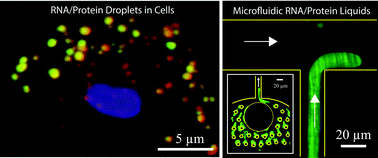Biophysical characterization of organelle-based RNA/protein liquid phases using microfluidics†
Abstract
Living cells contain numerous membrane-less RNA/protein (RNP) bodies that assemble by intracellular liquid–liquid phase separation. The properties of these condensed phase droplets are increasingly recognized as important in their physiological function within living cells, and also through the link to protein aggregation pathologies. However, techniques such as droplet coalescence analysis or standard microrheology do not always enable robust property measurements of model RNA/protein droplets in vitro. Here, we introduce a microfluidic platform that drives protein droplets into a single large phase, which facilitates viscosity measurements using passive microrheology and/or active two-phase flow analysis. We use this technique to study various phase separating proteins from structures including P granules, nucleoli, and Whi3 droplets. In each case, droplets exhibit simple liquid behavior, with shear rate-independent viscosities, over observed timescales. Interestingly, we find that a reported order of magnitude difference between the timescale of Whi3 and LAF-1 droplet coalescence is driven by large differences in surface tension rather than viscosity, with implications for droplet assembly and function. The ability to simultaneously perform active and passive microrheological measurements enables studying the impact of ATP-dependent biological activity on RNP droplets, which is a key area for future research.


 Please wait while we load your content...
Please wait while we load your content...